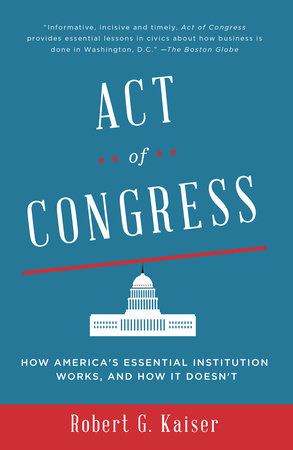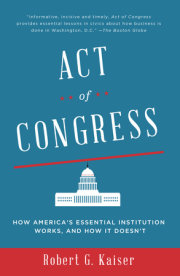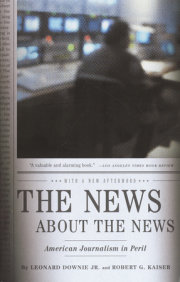Excerpted from the hardcover edition.
CHAPTER ONE
“I Could Hear Everyone Gulp”
Thursday, September 18, 2008, was a fine late-summer day in Washington—blue skies, temperatures in the seventies. But the politicians on Capitol Hill were in no mood to notice the weather. They were thoroughly distracted by chaos in the financial markets brought on by a series of seismic events: the nationalization of the government-supported agencies that provided most of the financing for home mortgages, Fannie Mae and Freddie Mac; then the sudden death of one enormous Wall Street institution, Lehman Brothers; and a unprecedented government bailout of another, the American International Group (AIG), a huge insurance company that traded financial products too. The stock market was suffering convulsions. The Dow Jones Industrials fell 504 points on Monday the 15th, the day Lehman Brothers went broke, then jumped 142 points on Tuesday, when the Federal Reserve Board, the American central bank, saved AIG, then dropped another 449 points on Wednesday, when several huge financial institutions were teetering.
The United States Congress is normally immune to emotional reactions. It is a ponderous institution, usually cautious and always reactive. But some events break through the protective layers of ceremony and custom that typically insulate the House and Senate from high emotion. One such event was unfolding in those September days.
“This is what a Category 4 financial crisis looks like,” members of Congress and other Washingtonians read on the front page of their morning newspaper that Thursday. Steven Pearlstein, The Washington Post’s economics columnist, captured the sinking feeling that gripped the nation’s capital: “Giant blue-chip financial institutions swept away in a matter of days. Banks refusing to lend to other banks. . . . Daily swings of three, four, five hundred points in the Dow Jones industrial average. What we are witnessing may be the greatest destruction of financial wealth that the world has ever seen—paper losses measured in the trillions of dollars. . . . Finance is still a confidence game, and once the confidence goes, there’s no telling when the selling will stop.”
Open-ended bad news, a national and global disaster bound to get still worse—this was a formula for unbridled fear among members of the House and Senate. They all knew that they would be blamed for whatever had gone wrong whenever angry voters got a chance to register their reactions. The politicians always got blamed—this was an article of their professional faith. Fear of being blamed might be the single most potent motivator in the House and Senate. When Congress actually does something dramatic or unexpected, fear is often the best explanation.
This financial crisis had undermined congressional confidence. In normal situations members and especially senior leaders exude a sense of being on top of events, in control. This is an act, and often misleading, but rarely exposed. During this week in September, the actors stumbled. Congress was visibly on the defensive. Its pretentious facade crumbled. On the 16th, when leaders of the House and Senate met with Hank Paulson, the secretary of the treasury, and Ben Bernanke, chairman of the Fed, the fear was palpable.
That meeting was scheduled as Paulson and Bernanke were finalizing the plan for the Fed to put $85 billion into AIG, transforming the gigantic firm into a ward of the state. Paulson realized they needed to give key members of both houses advance warning for what was about to happen. For decades, administrations of both parties had realized that Congress usually did not want to do much, but it always wanted to be consulted.
Paulson had arranged for such a consultation with Harry Reid, the Democratic senator from Nevada who was the majority leader. They would meet at 6:30 p.m. in the conference room of the Senate Rules Committee in the Capitol. The majority leader invited key senators and congressmen, including the chairmen of the two committees that had jurisdiction over the Fed, Senator Chris Dodd of Connecticut and Representative Barney Frank of Massachusetts. There were only a few chairs in the room, so all stood.
When Paulson and Bernanke explained what was going to happen, the room was hushed. “There was an almost surreal quality to the meeting,” Paulson later recounted. “The stunned lawmakers looked at us as if not quite believing what they were hearing.”
Frank and Dodd both marveled that the Fed had the legal authority to simply make $85 billion available to AIG without anyone else’s approval; theoretically these two men were responsible for overseeing the Fed. That evening they discovered that the central bank had powers they never knew existed. At the end of the meeting Senator Reid was blunt: “I want to be absolutely clear that Congress has not given you formal approval to take action. This is your responsibility and your decision.” That was the true voice of Congress, covering its own flanks before all else.
Now, on the 18th, Speaker Nancy Pelosi had gathered the leaders of her Democratic majority in her grand office on the second floor of the Capitol. On this day the stock market had perked up, apparently encouraged by rumors that the administration was planning some new initiative to help banks cope with their suddenly rotten housing assets. We need to get Hank Paulson up here to talk with us, Pelosi told her inner circle. “I’ll call him and set up a meeting for tomorrow.” After this meeting broke up, she put in a call to the treasury secretary. She wanted to be consulted.
For Paulson, a large, energetic man of high intellect, rich Wall Street experience, and no detectable political talent, this was another in a long string of very bad days. At nine that morning the vice chairman of Morgan Stanley had called to warn that his investment bank was teetering. The world’s banks refused to lend money to one another—credit markets were truly frozen. Disaster loomed. Paulson spent the next several hours exploring alternative responses to the crisis with Treasury colleagues. He spoke to President George W. Bush on the phone and arranged a meeting with him for that afternoon to discuss what to do. In a conference call with Bernanke and other Fed officials, everyone agreed that they would have to make a formal request to Congress to appropriate hundreds of billions of dollars to save the financial system.
No member of Congress was invited to join these conversations. This was typical of modern practice in a crisis: The executive would formulate a response, then bring it to Capitol Hill for approval. In this case, Paulson and Bernanke both realized how hard it would be to get Congress to put up so much money to bail out banks.
Paulson was walking from the Treasury to the White House next door when he took Pelosi’s call on his cell phone. She asked that he and Bernanke come up to Capitol Hill the next morning to brief the Democratic leadership.
“Madame Speaker,” Pelosi recalled Paulson replying, “it cannot wait until tomorrow morning. We have to come today.” Paulson explained “just how bad things were” and said he would be asking Congress for emergency powers. “We need legislation passed quickly. We need to send a strong signal to the market now.”
Paulson asked Pelosi to assemble a bipartisan group of senior members from both House and Senate to hear from him and Bernanke. Soon after this call ended, Bernanke and Paulson sat down in the Oval Office to explain the grim facts to President Bush: The administration would have to ask for an emergency appropriation of half a trillion dollars to save the financial system and prevent another Great Depression. The dazed president approved this plan.
Pelosi conveyed Paulson’s impatient message to her colleagues. They were taken aback. Paulson wanted an urgent meeting with House and Senate leaders, but waited for Pelosi to call him before saying so? “He hadn’t called us!” recalled Steny Hoyer, the number two Democrat in the House of Representatives. Pelosi told Hoyer the meeting was set for 7 p.m. Her staff invited the relevant members; Pelosi herself called Harry Reid, who invited the key senators.
Thanks to a sense of grandeur that animated the many creators of the Capitol of the United States, members of the House of Representatives and the Senate work in extraordinary physical spaces. Some are ridiculously ornate, some feel like transplanted Greek temples, some are quite beautiful. All convey a sense of importance—the sort of rooms that history is made in. Members often volunteer the thought that the Capitol’s splendor influences the attitudes of those who work in it.
Speaker Pelosi’s conference room on the second floor of what is called the Capitol’s west central front was a good example. It measures about fifteen feet by forty under vaulted ceilings decorated with classical designs and scenes from antiquity that look Roman. Ornate gilded moldings separate the ceiling from the walls that Pelosi’s decorator had painted in a soothing coffee-with-cream tone. A beige carpet with a repeating diamond motif covered the marble floor. The room was dominated by a handsome mahogany table at least twenty-five feet long, big enough to accommodate twenty-two armchairs. Another thirty of the same chairs lined the walls—seats for staff when large meetings were convened. Above the table a giant crystal chandelier hung from the vaulted ceiling. Three windows looked west over the magnificent Mall; the view included the Washington Monument and Lincoln Memorial in the distance. There was just one piece of art on the walls, an oil portrait of Abraham Lincoln as a young Illinois congressman, painted early last century—another reminder of the history made in this building.
The meeting in the conference room on this evening was unusual in many ways, but it provided a clear view of the congressional leadership reacting spontaneously to unexpected bad news. Pelosi took her usual seat in the middle of the long table, with her back to the windows. Harry Reid sat on her right. The table was decorated with three bouquets of fresh flowers and two bowls of nuts and chocolates—Ghirardelli chocolates from Pelosi’s hometown, San Francisco. The guests sat facing Pelosi and Reid: Bernanke, Paulson, several of his aides, and Chris Cox, a former Republican congressman from California who was the hapless chairman of the Securities and Exchange Commission, theoretically the regulator of many of the financial institutions now dead, dying, or endangered.
The others present were the two Republican leaders, Senator Mitch McConnell of Kentucky and Representative John Boehner of Ohio, who sat on Pelosi’s left; Dodd and Frank and the senior Republican members of their committees, Senator Richard Shelby of Alabama and Representative Spencer Bachus, also of Alabama; and other members of the leadership of both houses: Democratic senators Dick Durbin of Illinois, Chuck Schumer of New York, and Patty Murray of Washington; Republican representative Roy Blunt of Missouri; and Democratic representatives Rahm Emanuel of Illinois and James Clyburn of South Carolina. Pelosi had ordered that only a handful of staff be allowed into the room, and six or eight were present.
Of this group, only half a dozen had a reasonably good understanding of the financial markets: Dodd and Frank, Shelby and Bachus, Schumer—often called “the senator from Wall Street”—and Emanuel, a former investment banker. As Paulson had discovered in his two years in Washington, the gulf that divided Capitol Hill from Wall Street was wide and deep. Too many members of Congress neither understood finance, nor wanted to learn about it. A prominent Republican in the House had confided to Paulson that “one third of our guys are real knuckle-draggers”—cavemen, primitives. After two years on the job, Paulson knew this to be true.
Pelosi quickly turned the meeting over to Paulson, who anticipated a hostile reception when he asked members of Congress to approve hundreds of billions for the banks. They already suspected he was just trying to bail out his old friends on Wall Street, he had told Bernanke at the White House that afternoon, after their meeting with Bush. “They’ll kill me up there [on Capitol Hill]. I’ll be hung out to dry.”
Bernanke, an economics professor at Princeton before becoming a Federal Reserve Board governor in 2002, volunteered to speak first to exploit his considerable credibility. He had no Wall Street experience; he was an academic, an egghead, whose specialty was the Great Depression. He had the sort of rigorous, specialized expertise that can intimidate members of the House and Senate.
Paulson understood the mission. His chief of staff, Jim Wilkinson, a veteran of the Bush White House staff, had laid it out for him as he left the Treasury for Capitol Hill: “This is only going to work if you scare the shit out of them.” Paulson knew that Bernanke could do this best. So when Pelosi turned her meeting over to Paulson, he reported briefly on their session with President Bush that afternoon and on the president’s decision to propose new legislation, then asked Bernanke to describe the state of the financial system.
Bernanke handled himself like a professor leading a seminar, but a seminar with an unusual subject: the possible end of the world as we know it. He assumed no prior knowledge on the part of his class. He explained: They were facing a grave financial crisis. There had been a loss of confidence, and the markets were not working. There was a credit freeze. The commercial paper markets had ceased to operate. The stock market had dropped by more than a thousand points. The efforts he and Paulson had made to restore normalcy had proven inadequate, so they were now asking Congress to support an unprecedented appropriation of hundreds of billions of dollars to shore up the banks and head off total collapse. Bernanke said that he had been studying the Great Depression for his entire adult life. “If we don’t act in a very huge way, you can expect another Great Depression, and this is going to be worse,” he said sternly. “It is a matter of days before there is a meltdown in the global financial system.” And he warned, “Our tools are not sufficient” to deal with this crisis.
“This is a save-your-country moment,” said Cox of the SEC, implying that hundreds of billions of dollars was a tolerable expense under such extreme circumstances. It’s time to come together and act, Cox said. He knew his former colleagues, knew that wrapping the cause in the flag could help.
Senator Reid noted that the stock market was up sharply that day, suggesting that maybe they didn’t have to be so afraid. Bernanke dismissed this news—the market was up based on rumors that this meeting was going to take place, and that new government action would follow. If the expected actions didn’t materialize, Bernanke said, the market would plummet.
“I kind of scared them,” Bernanke said later. “I kind of scared myself.”
When Bernanke had finished his brief, terrifying lecture, Paulson spoke. In all his years at Goldman Sachs (thirty-two of them until he became treasury secretary in 2006), “I’ve never seen anything like this,” Paulson said. They were living through a once-in-a-century event. To salvage the situation, “we have to buy residential and commercial mortgages and mortgage-backed securities [from the banks that held them]. We need hundreds of billions of dollars to start off.” Congress, Paulson said, had to pass legislation at once—the next week—to allow Treasury to begin buying these toxic assets. Without action they faced a financial calamity. The country could collapse.
Copyright © 2014 by Robert Kaiser. All rights reserved. No part of this excerpt may be reproduced or reprinted without permission in writing from the publisher.










